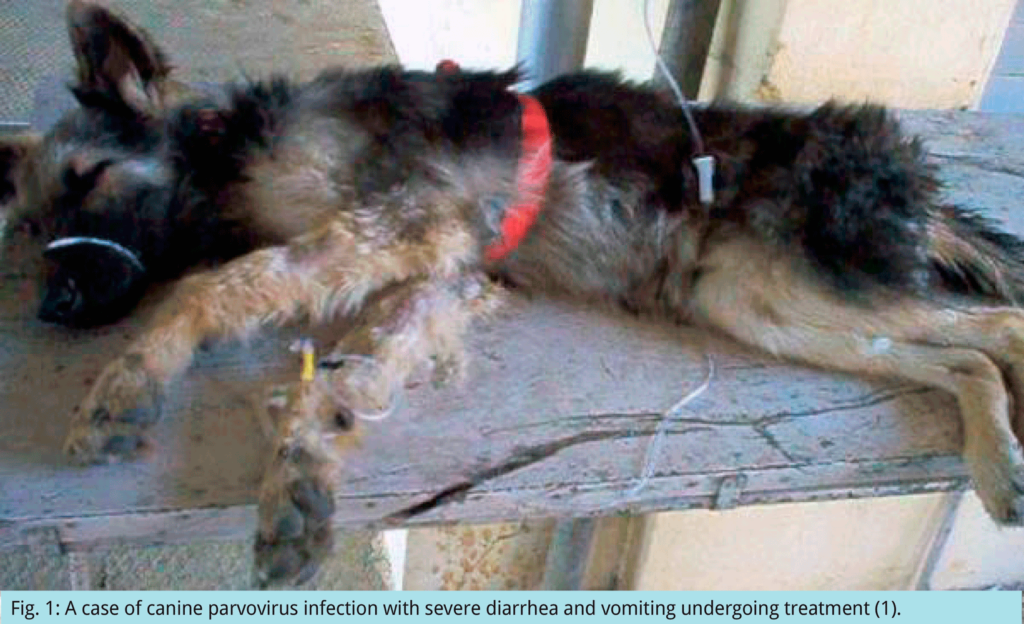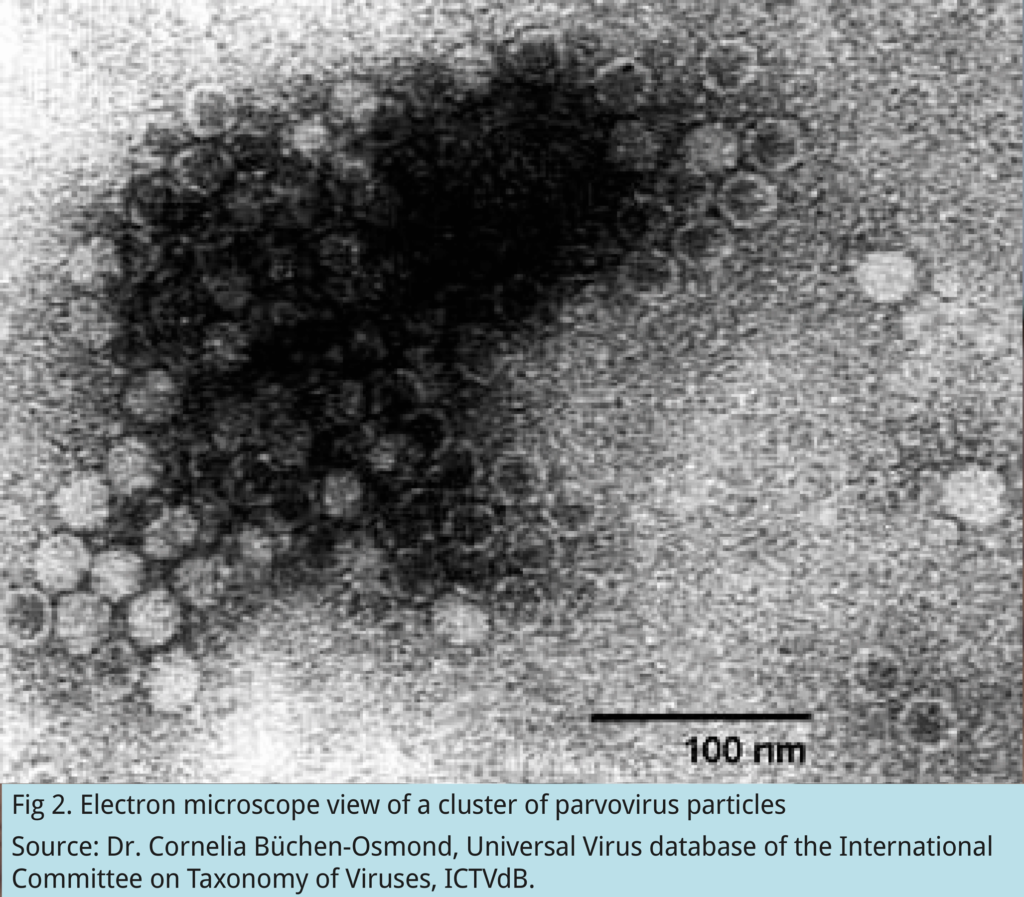
Parvovirus in Dogs: A Common Intestinal Ailment
Introduction
Canine parvovirus (CPV) is a highly contagious viral infection that can affect all unvaccinated dogs. Although its incidence has reduced due to early vaccination in puppies, it still continues to be a common intestinal infection affecting dogs.
Signs and Symptoms:
The virus manifests itself in two forms: The more common intestinal form and the less common cardiac form. The intestinal form can affect all unvaccinated dogs while the cardiac form affects young puppies between below eight weeks of age.
Intestinal CPV:
If the CPV infection is sub-clinical, there are no symptoms or mild signs of lethargy and appetite loss. This type of infection lasts for only a day or two. In the clinical type, the most common symptoms are:
• Vomiting
• Diarrhea, usually bloody
• Weight loss
• Lack of appetite
• Fever or hypothermia depending on severity
• Weakness
• Depression
• Dehydration due to vomiting and dehydration
• Tachycardia
• Leukopenia
Septic shock

Cardiac CPV:
The cardiac form of CPV attacks the heart muscles of puppies below eight weeks of age and leads to sudden death or sudden onset of congestive heart failure.
Cause:
CPV is a highly contagious virus that can affect all dogs, but unvaccinated dogs and puppies younger than four months old are the most at risk. CPV is caused by the Canine parvovirus type 2 (CPV2, commonly called parvo). The virus is very resistant to heat, cold and humidity. It is also resistant to common cleaning products and can survive for up to a year in soil.
In the intestinal manifestation, the virus is mainly transmitted by direct contact with an infected dog or its feces. Dogs come in contact with the virus through inanimate objects that have been contaminated by feces from an infected dog e.g. shoes, clothes, food, water etc. The incubation period is approximately four to six days and the virus is shed in the feces even before clinical symptoms appear. It also continues to be shed 10-14 days after recovery.
The biggest cause of infection is improper vaccination. Breeds such as Rottweilers, Doberman Pinschers, Pit Bulls, Labrador Retrievers, German Shepherds, English Springer Spaniels and Alaskan sled dogs are predisposed the infection. Underlying disease or a suppressed immune system may also make the dog vulnerable to CPV.
In the cardiac form, CPV is transmitted in utero from the mother or ingested in the neonatal period. The virus targets underdeveloped heart muscles in puppies and usually leads to death. Death occurs without any signs or some signs of respiratory distress. Fortunately, there are fewer cases of cardiac CPV due to routine parvovirus vaccinations in puppies.

Diagnosis:
Suspected diagnosis is based on the dog’s history, physical examination and laboratory tests. Usually the dog will show pain on abdominal palpitation. Laboratory tests such as fecal exams, biochemical tests, complete bold cell counts and urine analysis are used to confirm suspected diagnosis. If a dog shows any of the symptoms of CPV, it should be rushed to a veterinarian immediately. If untreated, CPV leads to death within 48 to 72 hours following the onset of clinical symptoms and mortality can reach as high as 91%.
Treatment and management:
Treatment is symptomatic as viral infections cannot be cured. The treatment for CPV is focused on restoration of fluid, electrolyte, and metabolic abnormalities and preventing secondary bacterial infections.
Oral electrolyte solution or colloid therapy is administered to ensure the dog’s condition does not deteriorate due to diarrhea and dehydration. Fresh or frozen plasma transfusions from a donor dog with CPV immunity is sometimes used to correct protein loss and provide immunity to the sick dog. Early enteral nutrition with a liquid diet is advised in dogs that are capable of eating.
Opioid analgesics and antidiarrheals are not recommended. Antiemetics for vomiting and H2-blockers against nausea are also administered. Broad-spectrum antibiotics such as cephalosporins are usually given intravenously to prevent secondary bacterial infections and leukopenia.
Dogs may succumb to CPV infection due to dehydration, secondary bacterial infection, septic shock or intestinal hemorrhage. Puppies have worse prognosis due to insufficiently developed immune systems and commonly show sudden death. However, pups that survive the first three or four days make a full recovery. With the right treatment, 68%–92% of dogs with CPV enteritis will survive. Dogs that recover develop long-term, possibly lifelong immunity.
Due to the highly contagious nature of the infection, it is important to isolate infected dogs. Kennels and housing should be thoroughly cleaned and disinfected. All the dog’s objects such as dishes, toys, leashes etc. should also be disinfected.
Even after recovery, the dog will have a weakened immune system and be susceptible to other diseases. It is important to boost its immunity. An easily digestible diet is recommended while recovering. The recovered dog will continue to be a source of infection for other dogs for at least two months. Hence it is advisable to isolate it from other dogs for this period of time.
Prevention:
The best way to prevent CPV is to follow the correct vaccination and hygiene protocol. Young puppies should be vaccinated at six, nine, and twelve weeks. They should not be allowed to socialize with unknown dogs till two weeks after their last vaccinations. In spite of proper vaccination, some dogs may not develop immunity and remain susceptible to infection.
Puppies and adult dog should not be allowed to come in contact with fecal matter of other dogs. Disposal of feces is recommended. Dogs that are unvaccinated or suspected to be infected should be isolated to prevent infecting healthy dogs. Dog handlers and owners in contact with sick dogs should observe proper hygiene such as washing hands and changing clothes immediately after contact.
References:
1. Nandi S, Kumar M. Canine Parvovirus: Current Perspective. Indian Journal of Virology. 2010;21(1):31-44. doi:10.1007/s13337-010-0007-y.
2. http://www.petmd.com/dog/conditions/infectious-parasitic/c_dg_canine_parvovirus_infection? page=1.
3. https://www.avma.org/public/PetCare/Pages/canine-parvovirus.aspx.
4. http://www.merckvetmanual.com/digestive-system/diseases-of-the-stomach-and-intestines-in- small-animals/canine-parvovirus.





No Comments